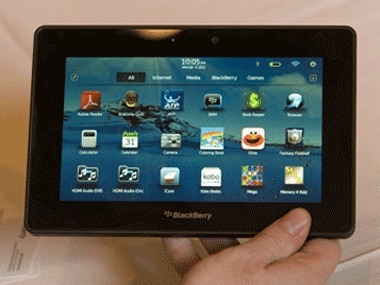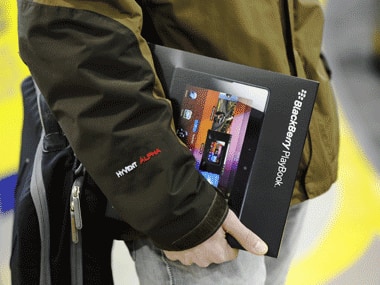Research in Motion’s iconic BlackBerry is considered the coolest smartphone brand in India thanks to the peer-induced, addictive allure of BlackBerry Messenger and the fact that Apple’s India pricing reveals it doesn’t give much of a damn about the Indian market since globally it has the most lucrative markets in its grip. I know of many in India who want the latest BlackBerry as soon as it’s out of RIM’s gates and many others who don’t activate the BlackBerry service but use a BlackBerry as a mere phone because they want to be seen with a ‘cool’ BlackBerry. [caption id=“attachment_29663” align=“alignleft” width=“380” caption=“Will Indian customers flock to the PlayBook as they seem to do with BlackBerry smartphones? Reuters”]
 [/caption] With the much-anticipated BlackBerry PlayBook tablet launching in India today (a few months after its April launch in the US), will Indian customers flock to the PlayBook as they seem to do with BlackBerry smartphones? And more importantly, should they flock to it? The PlayBook is crucial for RIM, whose market share has fallen in key markets like the US thanks to smartphones powered by a visibly aging operating system, or OS, and almost obsolete hardware specs when compared with other top-of-the-line competitors. The PlayBook itself is great in almost every way — I’ve used a review unit for more than a week now. It looks great, is solidly built and features a brilliant display, great speakers and very good dual cameras. And at 7” it’s also more portable as compared to its 10” brethren. The new QNX OS (officially BlackBerry Tablet OS) is an admirable piece of work, especially if all you’ve been used to is the bug-infested Microsoft Windows. QNX also has excellent pedigree, and versions are in use in high-end routers, nuclear power plants and the like. Seriously. Okay, not the exact same software but I am sure there are a few lines of code in common. When you add a 1GHz dual-core processor to the mix, the result is blazing performance. The touchscreen works well and getting used to the gestures and swipes needed is a breeze. And the browser’s almost a dream come true — full Flash support here with text, graphics and video rendering just as well as on a desktop. The problems lies in the apps built for the PlayBook. It’s almost like RIM built a supercar but there’s hardly any road to drive it on. The PlayBook comes bundled with a decent set of tools for the average business user but the average consumer gets a raw deal. And the app store is as packed with apps as a supermarket in a war-torn city in Libya. Unlike the iPad, which can run almost all the hundreds of thousands of iPhone apps, even existing BlackBerry apps won’t run on the PlayBook since QNX is an all-new OS. Ouch. Continue reading on the next page Closer home we do know that RIM is working closely with Indian app developers and is wooing them very aggressively. At last count I believe RIM had over 20,000 Indian developers building apps and thousands more are being added almost every month. Some of this will show in the 100-odd apps from India that would be available for the PlayBook. But the fact is, they need tens of thousands more to be relevant. [caption id=“attachment_29669” align=“alignleft” width=“380” caption=“because of the dearth of apps, the PlayBook will remain a companion to the BlackBerry smartphone at least for now. Reuters”]
[/caption] With the much-anticipated BlackBerry PlayBook tablet launching in India today (a few months after its April launch in the US), will Indian customers flock to the PlayBook as they seem to do with BlackBerry smartphones? And more importantly, should they flock to it? The PlayBook is crucial for RIM, whose market share has fallen in key markets like the US thanks to smartphones powered by a visibly aging operating system, or OS, and almost obsolete hardware specs when compared with other top-of-the-line competitors. The PlayBook itself is great in almost every way — I’ve used a review unit for more than a week now. It looks great, is solidly built and features a brilliant display, great speakers and very good dual cameras. And at 7” it’s also more portable as compared to its 10” brethren. The new QNX OS (officially BlackBerry Tablet OS) is an admirable piece of work, especially if all you’ve been used to is the bug-infested Microsoft Windows. QNX also has excellent pedigree, and versions are in use in high-end routers, nuclear power plants and the like. Seriously. Okay, not the exact same software but I am sure there are a few lines of code in common. When you add a 1GHz dual-core processor to the mix, the result is blazing performance. The touchscreen works well and getting used to the gestures and swipes needed is a breeze. And the browser’s almost a dream come true — full Flash support here with text, graphics and video rendering just as well as on a desktop. The problems lies in the apps built for the PlayBook. It’s almost like RIM built a supercar but there’s hardly any road to drive it on. The PlayBook comes bundled with a decent set of tools for the average business user but the average consumer gets a raw deal. And the app store is as packed with apps as a supermarket in a war-torn city in Libya. Unlike the iPad, which can run almost all the hundreds of thousands of iPhone apps, even existing BlackBerry apps won’t run on the PlayBook since QNX is an all-new OS. Ouch. Continue reading on the next page Closer home we do know that RIM is working closely with Indian app developers and is wooing them very aggressively. At last count I believe RIM had over 20,000 Indian developers building apps and thousands more are being added almost every month. Some of this will show in the 100-odd apps from India that would be available for the PlayBook. But the fact is, they need tens of thousands more to be relevant. [caption id=“attachment_29669” align=“alignleft” width=“380” caption=“because of the dearth of apps, the PlayBook will remain a companion to the BlackBerry smartphone at least for now. Reuters”]
 [/caption] One way RIM wants to solve this conundrum is a plan to release emulators that will allow the PlayBook to run Android apps. That’s still in the pipeline though and initial release plans have been delayed. One needs to wait and see how well RIM actually delivers on this promise. Though native email, calendar and memo apps are not available yet (another app grouse), if you are a BlackBerry user you can use BlackBerry Bridge to tether your smartphone to the PlayBook and you’ll be able to access your email, calendar, BlackBerry Messenger, memos and even browse in the absence of Wi-Fi connectivity using the Bridge browser. CIOs at enterprises who feel a special kinship towards BlackBerry because of its enterprise-grade security capabilities would be delighted at this because Bridge ensures that no data resides on the PlayBook. The minute the Bridge connection is broken, the cache on the PlayBook is cleared and the Bridge menu simply disappears. Another reason CIOs might prefer the lack of native email apps is that since users need to check email through the browser when not using Bridge, no data again resides on the tablet. Unless of course an exec downloads a spreadsheet containing important details of all customers to the PlayBook and then manages to lose it. But because of the dearth of apps, the PlayBook will remain a companion to the BlackBerry smartphone at least for now. Which is sad because tablets are not supposed to be appendages to a smartphone. On the other hand RIM also may have set up the foundation for a future winner here. Unlike Nokia, which killed MeeGo (and many geeks consider it hara-kiri), RIM has displayed the guts to drive innovation on its own strength and go for a whole new OS rather than merely adopt someone else’s. Priced at Rs 27,990 for the 16 GB version, Rs 32,990 for the 32GB and Rs 37,990 for the 64 GB one, the PlayBook doesn’t come cheap and considering the lack of app depth to support the PlayBook, may be priced a tad too high. The bottom line: If you’re high up on the corporate ladder your company might hand you a PlayBook. RIM has strong sales capabilities and relationships in the enterprise space and expect RIM India to push all the buttons on this one. Else, if you’re a BlackBerry power user or fanatic, you should try the PlayBook, but if you’re not, it might be a good idea to wait till RIM gets its apps act right, and especially that much-awaited silver bullet, the Android emulator. By then you may also have version 2 of the BlackBerry PlayBook. For the complete review with technical jargon and specs, please visit www.tech2.com.
[/caption] One way RIM wants to solve this conundrum is a plan to release emulators that will allow the PlayBook to run Android apps. That’s still in the pipeline though and initial release plans have been delayed. One needs to wait and see how well RIM actually delivers on this promise. Though native email, calendar and memo apps are not available yet (another app grouse), if you are a BlackBerry user you can use BlackBerry Bridge to tether your smartphone to the PlayBook and you’ll be able to access your email, calendar, BlackBerry Messenger, memos and even browse in the absence of Wi-Fi connectivity using the Bridge browser. CIOs at enterprises who feel a special kinship towards BlackBerry because of its enterprise-grade security capabilities would be delighted at this because Bridge ensures that no data resides on the PlayBook. The minute the Bridge connection is broken, the cache on the PlayBook is cleared and the Bridge menu simply disappears. Another reason CIOs might prefer the lack of native email apps is that since users need to check email through the browser when not using Bridge, no data again resides on the tablet. Unless of course an exec downloads a spreadsheet containing important details of all customers to the PlayBook and then manages to lose it. But because of the dearth of apps, the PlayBook will remain a companion to the BlackBerry smartphone at least for now. Which is sad because tablets are not supposed to be appendages to a smartphone. On the other hand RIM also may have set up the foundation for a future winner here. Unlike Nokia, which killed MeeGo (and many geeks consider it hara-kiri), RIM has displayed the guts to drive innovation on its own strength and go for a whole new OS rather than merely adopt someone else’s. Priced at Rs 27,990 for the 16 GB version, Rs 32,990 for the 32GB and Rs 37,990 for the 64 GB one, the PlayBook doesn’t come cheap and considering the lack of app depth to support the PlayBook, may be priced a tad too high. The bottom line: If you’re high up on the corporate ladder your company might hand you a PlayBook. RIM has strong sales capabilities and relationships in the enterprise space and expect RIM India to push all the buttons on this one. Else, if you’re a BlackBerry power user or fanatic, you should try the PlayBook, but if you’re not, it might be a good idea to wait till RIM gets its apps act right, and especially that much-awaited silver bullet, the Android emulator. By then you may also have version 2 of the BlackBerry PlayBook. For the complete review with technical jargon and specs, please visit www.tech2.com.
BlackBerry PlayBook: Not much to play with
Ivor Soans
• June 25, 2011, 16:32:12 IST
If you’re a BlackBerry power user, you should try the PlayBook, but if you’re not, it might be a good idea to wait till RIM gets its apps act right.
Advertisement
)